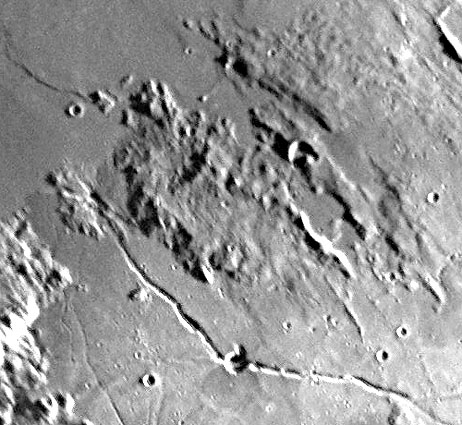Difference between revisions of "April 8, 2004"
| Line 14: | Line 14: | ||
<table width="100%" border="0" cellpadding="8"> | <table width="100%" border="0" cellpadding="8"> | ||
<tr> | <tr> | ||
| − | <td><div align="center" span class="main_sm">Image Credit: [mailto:legault@club-internet.fr Thierry LeGault]</div></td> | + | <td><div align="center" span class="main_sm"><p>Image Credit: [mailto:legault@club-internet.fr Thierry LeGault]</div></td> |
</tr> | </tr> | ||
</table> | </table> | ||
Revision as of 22:12, 17 January 2015
Sneaky Schneckenberg
Image Credit: Thierry LeGault |
|
Sneaky Schneckenberg Schneckenberg is German for Snail Mountain, and if you look closely at the strange spiral-like feature at the center of this image you can see how well the name fits. Schneckenberg is nomenclaturally confusing, as well as topographically bizarre. The selenographer J. N. Krieger added the name in the late 1800s, and it was later included in the official International Astronomical Union listing of 1935. But by 1961 the IAU decided the feature was neither a crater nor a mountain and so the name was officially deleted. But if you want to talk about it, Schneckenberg is the only name available; Sneaky Schneck has snuck back in! So what is the odd landform that has been a mystery for more than 100 years? I think the answer is easy! The area immediately north of Schneckenberg is lumpy but delicately striated. The narrow lineations are radial to Imbrium. This lumpy piece of terrain is part of the massive ejecta blanket deposited by the formation of the Imbrium basin. It must be hundreds of meters thick here, and has buried a number of pre-existing craters - which may have formed as basin secondaries only minutes earlier. Hyginus W is obviously a crater (or more than one) that has mostly escaped total burial, but only the sides of its rim that are radial to Imbrium have survived. Other linear remains of crater walls occur between the fresh craters Hyginus E, F and C. And look to the east at Boscovich, Julius Caesar and many similar craters instantaneously aged by Imbrium. The two white arrows mark the rim of a crater that has been almost completely covered by Imbrium ejecta. Now you should be able to see that Schneckenberg is just the remnants of a crater that has been heavily veneered by Imbrium ejecta. Only a small part of the original crater's rim peeks out as a bright ridge. Technical Details: This image is from Thierry LeGault, but CAW has highly enhanced and over-sharpened it to show features around Schneckenberg. Related Links: Krieger's Drawing: The Astronomical Scrapbook by J. Ashbrook (Sky Publishing Corp, 1984), p. 261. Tomorrow's LPOD: Copernicus on the Limb |
Author & Editor:
Charles A. Wood
Technical Consultant:
Anthony Ayiomamitis
A service of:
ObservingTheSky.Org
Visit these other PODs:
Astronomy | Mars | Earth
COMMENTS?
Register, and click on the Discussion tab at the top of the page.




